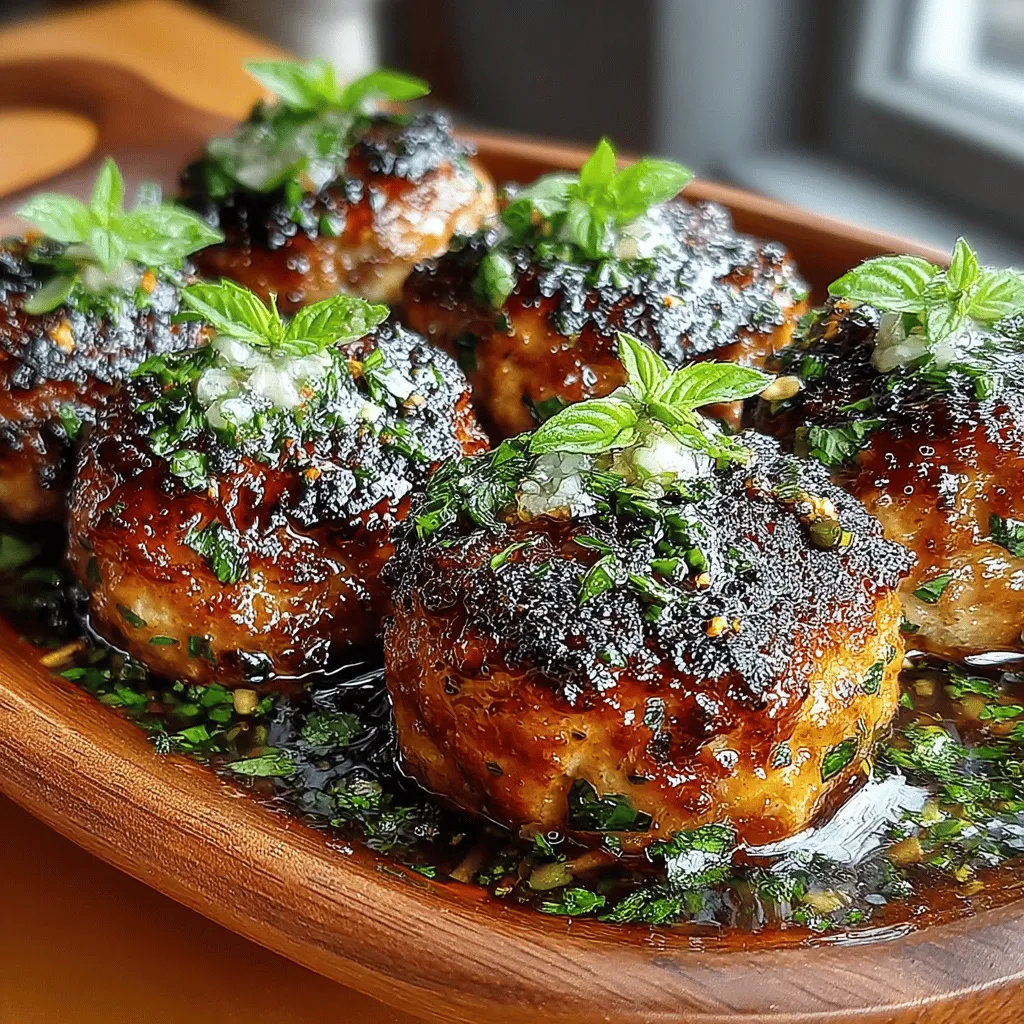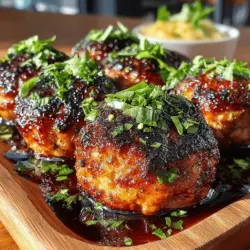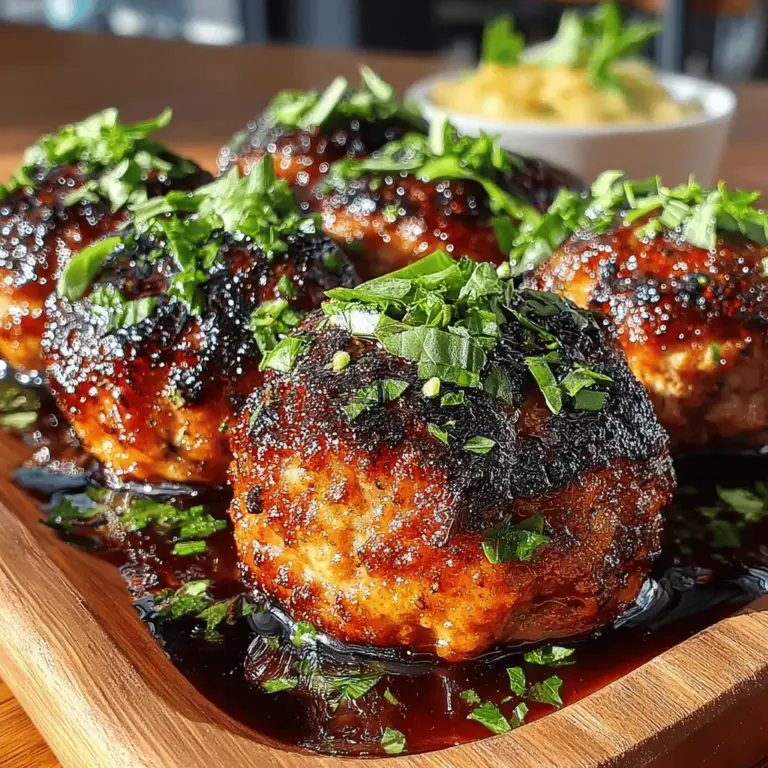Introduction to Baked Balsamic Vinaigrette Meatballs
Baked Balsamic Vinaigrette Meatballs are a delicious and innovative take on traditional meatballs, merging the comforting flavors of seasoned ground meat with the rich, tangy sweetness of balsamic vinaigrette. This dish not only serves as a hearty dinner option but also shines as an impressive appetizer for gatherings and parties. With the versatility to cater to various dietary preferences, you can easily opt for either ground beef or turkey, making it a suitable choice for many different palates. The preparation is straightforward, and the result is a flavorful dish that’s sure to impress family and friends alike.
Originating from Italian cuisine, meatballs have long been a staple in many households, often served with pasta or as part of a sub sandwich. However, the addition of balsamic vinaigrette elevates this classic dish to new heights, introducing a delightful balance of flavors. The acidity of the balsamic vinegar cuts through the richness of the meat, while the accompanying ingredients in the vinaigrette complement the savory notes perfectly. Whether you’re looking for a comforting family meal or a standout appetizer for your next gathering, Baked Balsamic Vinaigrette Meatballs are an excellent choice that can fit any occasion.
Understanding the Ingredients
Overview of Key Ingredients
To create the perfect Baked Balsamic Vinaigrette Meatballs, it’s essential to understand the role of each ingredient in the recipe. The star of the dish is undoubtedly the ground meat, which can be either beef or turkey. Ground beef is known for its robust flavor and juiciness, making it a popular choice for meatballs. It provides a rich, hearty base that pairs wonderfully with the tangy balsamic vinaigrette. On the other hand, ground turkey offers a leaner alternative, making it a great option for those looking to reduce fat intake while still enjoying a satisfying meatball. Turkey has a milder flavor that allows the other ingredients, particularly the vinaigrette, to shine through, catering to those who prefer a lighter dish.
In addition to the meat, Italian seasoned breadcrumbs and Parmesan cheese play crucial roles in enhancing both the flavor and texture of the meatballs. The breadcrumbs help bind the ingredients together while adding a delightful crunch. Using Italian seasoned breadcrumbs infuses the meatballs with traditional Italian herbs and spices, enhancing their overall taste. Parmesan cheese, known for its salty, nutty flavor, adds a depth that complements the savory meat and the tangy balsamic sauce.
Herbs and spices are also vital in this dish. Oregano and basil are cornerstone ingredients in Italian cuisine, bringing an aromatic quality to the meatballs. Oregano contributes a slightly bitter, earthy flavor, while basil adds a sweet, peppery note. Together, they create a balanced and flavorful profile, making each bite of meatball a delight.
Making the Balsamic Vinaigrette Sauce
The balsamic vinaigrette is what sets this recipe apart from traditional meatballs. Balsamic vinegar, with its origins in Modena, Italy, is a staple in many kitchens around the world. Its complex flavor profile, characterized by a sweet, slightly tangy taste, makes it an excellent complement to meat dishes. The acidity of balsamic vinegar not only enhances the flavor of the meatballs but also helps to tenderize the meat, creating a succulent final product.
To balance the acidity of the balsamic vinegar, a sweetener is often added. In this recipe, you can choose between honey and maple syrup. Honey provides a floral sweetness that harmonizes beautifully with the tanginess of the vinegar, while maple syrup introduces a deeper, earthy sweetness. Both options work well, allowing you to tailor the dish to your personal taste preferences.
Another essential ingredient in the balsamic vinaigrette is Dijon mustard. This ingredient serves two primary purposes: it helps emulsify the vinaigrette, creating a smooth and cohesive sauce, and it adds a layer of depth to the flavor profile. The slight spiciness of Dijon mustard complements the sweetness and acidity of the vinegar, enhancing the overall taste of the meatballs.
Step-by-Step Instructions for Baked Balsamic Vinaigrette Meatballs
Prepping for Success
Before diving into the mixing of ingredients, it’s important to prepare your kitchen for success. Start by preheating your oven to 400 degrees Fahrenheit. This step is crucial, as it ensures that the meatballs cook evenly and develop a nice, golden-brown exterior. To facilitate easy cleanup and to prevent the meatballs from sticking, line a baking sheet with parchment paper. This simple step can save you time and effort when it comes time to serve.
Next, take the time to measure and prep your ingredients efficiently. Having everything ready to go not only streamlines the cooking process but also ensures that you won’t miss any components. Gather your ground meat, breadcrumbs, cheese, herbs, and the ingredients for the balsamic vinaigrette, and set them out in an organized manner. This preparation will make the mixing and forming process much smoother.
Combining Ingredients for Perfect Meatballs
With your ingredients prepped and your oven ready, it’s time to combine them to create the meatballs. Begin by placing your chosen ground meat into a large mixing bowl. Add in the Italian seasoned breadcrumbs, grated Parmesan cheese, and your selected herbs – oregano and basil. It’s important to mix these dry ingredients together first to ensure even distribution of flavors throughout the meat.
When it comes to mixing the meatball ingredients, the technique matters. Use your hands or a spoon to combine the ingredients gently. Overworking the mixture can lead to tough meatballs, so aim to mix just until everything is combined. You want the mixture to be cohesive but not dense. Once your ingredients are well-mixed, it’s time to form the meatballs.
To achieve uniform sizes, which is essential for even cooking, consider using a cookie scoop or your hands to portion out the mixture. Aim for meatballs that are about 1 to 1.5 inches in diameter. This size ensures they cook through without drying out. As you shape each meatball, gently roll them in your hands to create a smooth surface. This not only improves the appearance of the meatballs but also helps them hold together during baking.
Baking the Meatballs to Perfection
Once all the meatballs are formed and placed on the prepared baking sheet, it’s time to bake them to perfection. Depending on the size of your meatballs, they typically require about 20-25 minutes in the preheated oven. The goal is to achieve a golden-brown exterior while ensuring the interior is cooked through and juicy.
As they bake, the aromas will begin to fill your kitchen, creating an inviting atmosphere. Halfway through the baking time, you may want to rotate the baking sheet to ensure even cooking. Once the meatballs are done, you can toss them in the balsamic vinaigrette sauce, allowing each meatball to soak up the flavors before serving.
These Baked Balsamic Vinaigrette Meatballs offer a delightful twist on a classic dish, providing a medley of flavors that will satisfy any crowd. Stay tuned for the next section, where we will explore serving suggestions, pairing options, and tips for storing or reheating these scrumptious meatballs.

Baking Process
Cooking meatballs to perfection is an art that combines the right temperature and timing with attentive observation. For the best results, preheat your oven to 375°F (190°C). This moderate temperature ensures that the meatballs cook through without drying out, allowing the flavors to meld beautifully.
Importance of Cooking Temperature and Time
When baked at the right temperature, meatballs should take approximately 25 to 30 minutes to cook. However, the key to determining doneness is not merely based on time. Instead, you should look for a few telltale signs:
1. Color: Once cooked, meatballs should exhibit a golden-brown exterior. This color indicates proper caramelization, enhancing their flavor profile.
2. Internal Temperature: Use a meat thermometer to check the internal temperature, which should reach at least 165°F (74°C) for safe consumption. This is particularly important for poultry-based meatballs.
3. Juices: When pierced, the juices should run clear. If they appear pink or red, the meatballs need more time in the oven.
Taking these signs into account will ensure perfectly baked meatballs every time.
Crafting the Balsamic Vinaigrette Sauce
A delightful balsamic vinaigrette enhances the flavors of your meatballs, providing a tangy contrast that elevates the dish.
Whisking it Together
The process of emulsifying your vinaigrette is crucial for achieving a creamy texture that clings beautifully to the meatballs.
Emulsification Explained
Emulsification is the technique of combining two liquids that typically do not mix, such as oil and vinegar. When making your balsamic vinaigrette, begin by whisking together the balsamic vinegar, Dijon mustard, and a pinch of salt in a bowl. Next, slowly drizzle in the olive oil while whisking vigorously. This action breaks down the oil into tiny droplets, dispersing them evenly throughout the vinegar mixture.
Flavor Balancing
Once emulsified, it’s essential to taste and adjust the seasoning. The balance of acid and sweetness is key. If you prefer a sweeter vinaigrette, add a touch of honey or maple syrup. Conversely, for a more robust flavor, incorporate additional balsamic vinegar or a pinch of crushed red pepper flakes for a hint of heat. Strive for a flavor that pleases your palate, as this sauce will significantly impact the overall dish.
Combining Meatballs and Sauce
The final step in creating your Baked Balsamic Vinaigrette Meatballs is combining the meatballs with the sauce for a harmonious blend of flavors.
Creating a Harmonious Dish
Once your meatballs are baked to perfection, it’s time to integrate them into the sauce.
Simmering Techniques
Transfer the baked meatballs into a skillet over low heat, then pour the balsamic vinaigrette sauce over them. Allow the meatballs to simmer in the sauce for about 5 to 10 minutes. This step is crucial as it allows the meatballs to absorb the vinaigrette’s flavors, creating a unified dish. The gentle heat keeps the meatballs warm while ensuring the sauce thickens slightly, coating the meatballs beautifully.
Final Touches
As the meatballs simmer, keep an eye on the sauce’s consistency. If it appears too thin, let it simmer a bit longer to reduce and thicken. Stir occasionally to prevent sticking, and adjust the seasoning if necessary. The perfect sauce should be rich and glossy, enveloping the meatballs without overpowering their flavor.
Serving Suggestions for Baked Balsamic Vinaigrette Meatballs
Once your meatballs are beautifully coated in balsamic sauce, it’s time to serve this delicious dish.
Creative Serving Ideas
These meatballs are versatile and can be served in various ways, making them suitable for any occasion.
Classic Pairings
A classic way to enjoy Baked Balsamic Vinaigrette Meatballs is to serve them over a bed of spaghetti. The combination of pasta and sauce creates a comforting dish that is sure to please any crowd. Alternatively, consider using the meatballs as a filling for sub sandwiches, topped with melted cheese and fresh basil for an Italian-inspired treat.
Accompaniments
To round out your meal, serve the meatballs with complementary side dishes. Roasted vegetables, such as zucchini, bell peppers, or asparagus, bring a colorful and nutritious element to the plate. A fresh salad, featuring mixed greens, cherry tomatoes, and a light vinaigrette, adds brightness and crunch to balance the richness of the meatballs.
Nutritional Information and Serving Size
Understanding the nutritional content of your meal can help you make informed choices.
Breakdown of Nutritional Content
Baked Balsamic Vinaigrette Meatballs provide a hearty serving of protein and flavor. A standard serving size of four meatballs (approximately 200 grams) contains around 350 calories. This estimate can vary depending on the specific ingredients used, such as the type of meat or the amount of olive oil in the vinaigrette.
Caloric Overview
For those looking to reduce calories without sacrificing flavor, consider using lean ground turkey or chicken instead of beef or pork. Additionally, you can substitute half of the olive oil in the vinaigrette with vegetable broth to lower the calorie count while still maintaining a robust flavor.
Portion Control
When entertaining, or even for everyday meals, managing portion sizes can help maintain a balanced diet. Consider serving Baked Balsamic Vinaigrette Meatballs with whole-grain pasta or a generous helping of vegetables to create a more satisfying meal with fewer meatballs per serving. This tactic not only enhances nutritional value but also encourages mindful eating.
Conclusion: Enjoying Your Baked Balsamic Vinaigrette Meatballs
Baked Balsamic Vinaigrette Meatballs are not just a meal; they are a culinary experience that showcases the beauty of combining simple ingredients to create something extraordinary. With their easy preparation and delightful flavors, these meatballs are perfect for any occasion, from family dinners to festive gatherings. Whether served over pasta, as a sandwich, or alongside fresh vegetables, this dish is bound to impress.
Embrace this recipe and enjoy the satisfaction it brings to your table. By experimenting with different sides and serving methods, you can create a memorable meal that caters to your taste preferences. Dive into this delightful dish, and let the flavors of balsamic and herbs transform your dining experience!

